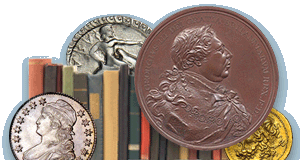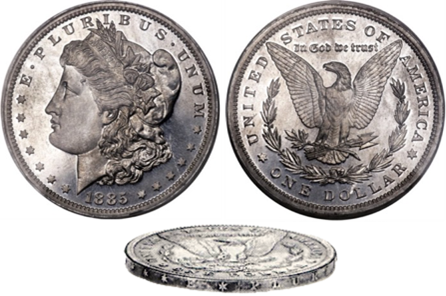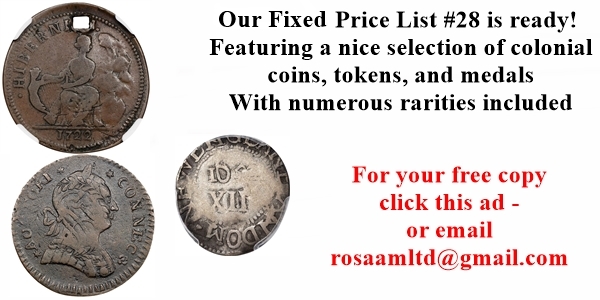
PREV ARTICLE
NEXT ARTICLE
FULL ISSUE
PREV FULL ISSUE
MORE ON THE 16TH 1804 DOLLAR PROVENANCEDoug Ward submitted these additional thoughts on the provenance of the 16th 1804 dollar. Thank you. -Editor More on the 1804 Dollar Provenance Thanks to John Dannreuther for his further commentary. I believe we agree in principle. I have one question that's been a sticking point for me. I have read a number of articles which recounted the "two heavy trunks in a wagon" story (or was it three?), but I have not seen any documents or written account of this incident. Maybe John or others have such information? I doubt it occurred, since auction appearance records do not reflect the continued introduction of patterns to the market place after 1885, or the 1892 Woodside auction. This, despite that more than 400 patterns had not appeared until after 1910. Also, without a substantial Mint hoard as a trade, why would Mr. Woodin return the Half Unions to the Mint? Documentation confirmed that the Treasury department dropped its interest in them when their claims were reduced to off-metal patterns. Provenance Post Script The fate of a significant coin collection consisting of cherished mementoes representing one's earthly exploits is usually handled by an auction company these days. Thus, the perceived maximum return on investment can be extracted and the proceeds distributed amongst heirs. This can be done in either the present life or posthumously. In the event of an untimely demise, the arrangements are orchestrated by an executor. Such was the case in the settlement of Dr. Linderman's estate and dissemination of his collection of pattern pieces. Among his trophies was a Class III 1804 Dollar. He undoubtedly played a central role in the propagation of this enigma, including its sisters. The sale of his collection is well known and was messy, and finally came in 1888 after its seizure and a legal brawl that severely tarnished the reputation of the Director and his family. His wife was likely forced to lie, specifically regarding the origin of Dr. Linderman's infamous dollar dated 1804. It would stretch credibility to believe he had bought it from the same dealer whom he, or more likely his protégé Col. Snowden, had relied on to sell them. While in restly repose, Dr. Linderman would be oblivious to the consternation his unsettled exploits had caused his dear wife and family. Such would not be the case for Col. Snowden, who surely filed away the unsavory events for future reference. After his employment with the Treasury Department, he moved on to the State Department and elevated his stature amongst the political and societal elite. Reputed to be a talented orator, he further leveraged his social skills after departing the Mint in 1885. In 1887, he was chosen to be the Marshal of the Centennial celebration of the United States Constitution. During the early 1890's, his family would enjoy the perks of his ambassadorships to Greece, Romania, Serbia and Spain. His daughters and son would marry further into social circles. U. S. Minister A. Louden Snowden and his son Charles Randolf Snowden (right) with William Sachtleben in front of the U. S. Embassy, Athens, Greece, March 12 th , 1891. (Image courtesy of UCLA Library Digital Collections.) As his grandchildren were born and grew up in this privileged backdrop, and Col. Snowden enjoyed the fruits of his labor and loins, he was seemingly haunted. Ghostly visitations were not only by the fate of his mentor's collection and family, but also by the prophetic words of W. Elliot Woodward, a prolific dealer and trusted fence. His advice in 1863, came with the sale of four 1862 ‘God Our Trust' patterns and the "strict injunction that they must never be sold, unless by a sheriff or executor." It is strangely possible that these were actually Col. Snowden's own words, or those of his mentor, coming back to haunt him. In any event, it's evident he decided against his executor and leaving the fate of his trophies, mementoes and family to chance and Treasury authorities. He would sell his collection. All he needed was a sheriff and a plan. Enter Edgar H. Adams and what transpired as the Great Pattern Plot. 1862 Ten-dollar Eagle ‘God Our Trust' pattern struck in copper, J297. (Image from the Eric P. Newman Collection, Part 1, courtesy of the Newman Numismatic Portal and Heritage Auctions.) This scenario was not lost on researcher Walter H. Breen, who's words regarding other numismatic accumulations were lost on most subsequent researchers and writers. In 1952 he would write for The Numismatist:
"The above completes the listing of hoards in the proper sense of the word, at least of those hoards about which information has been available to me. It will be noticed that I have omitted all mention of so-called hoards which were really accumulations for numismatic purposes. This takes care of the so-called "South Shore hoard" of cents, as well as the Snowden hoard comprising unsold numismatic materials including thousands of patterns, restrikes and mules and similar pieces de caprice, along with material like the 1873-cc dime without arrows. (This last seems to have been a leftover from the February 1874 meeting of the Assay Commission? … and recall that the only pieces the Carson Dity mint had to send to Philadelphia were assay coins.) This Snowden accumulation left the mint about 1909 in settlement with Mr. Woodin for the two $50 pieces in gold." As previously mentioned, lost amongst this vast menagerie was a Class III 1804 Dollar. 115 years later, none of the fifteen known can be attributed to Col. Snowden, whom otherwise is linked to most Mint emissions of pattern, trial and experimental pieces produced from the mid-1860's onward. The reverse die unique to Class II and all Class III specimens, is shared by the Stack coin. Its characteristics include rust marks, specifically on and around the left upright of the U in UNITED. The reverse die was destroyed in 1860, limiting the Class III coins to those already struck. The obverse die was destroyed in 1869 with no other known impressions. As with the other Class III specimens, the Stack coin must be cupped. All were subsequently edge lettered using the Castaing machine sometime after their striking. In 1869, a Class III 1804 Dollar was first offered to collectors, likely placing their edge lettering under the dominion of Col. Snowden. This would indicate that he and Dr. Linderman had first pick of available specimens, since the condition of both seems similar and the best among those known. Indeed, the condition of the Linderman coin is estimated to be PR63, and the grade of the others becomes lower with subsequent acquisition date. Although graded PR65, who had real control may be further revealed by the edge lettering on the Stack coin. The edge lettering on the Linderman coin is described as blundered. The 1885 Snowden pattern dollar struck in aluminum, J1749. Edge lettering was intended to deter counterfeiting. (Courtesy of USPatterns.com and Heritage Auctions.) Class III 1804 Dollar Origins 1. 1868 or 1869: Dr. Linderman – acquired from the Mint – est. PR63. 2. 1868 or 1869: William Idler – acquired from Capt. Haseltine, who was sworn to secrecy – est. PR60. 3. 1875: sold by a Vienna auction house – an early fencing ploy by Capt. Haseltine? – est. PR55. 4. 1876: Phineas Adams – acquired from Capt. Haseltine – PR58. 5. 1877: Robert Colton Davis – acquired from Capt. Haseltine – est. PR40. 6. 1893: James W. Ellsworth from W. Julius Driefus with strange & dubious early history – est. PR40. Of the original Class III 1804 Dollars owners, William Idler's is the earliest reported acquisition, possibly occurring around 1868. In 1908, Capt. Haseltine described the coin as having been owned by Mr. Idler for forty years and that he was sworn to secrecy. In 1875, a specimen surfaced with a Vienna auction house, presumably an early fencing ploy. In 1876, Capt. Haseltine exhibited another that was then sold to Phineas Adams. Famed and first pattern cataloguer Robert Colton Davis bought another from Haseltine in 1877. Linderman's piece was certainly acquired earlier and was in his collection when he died in 1879. The sixth and last to surface appeared in 1893 with evidence of circulation and no clear earlier owner. One hundred and thirty-one years later, the sixteenth specimen now appears – Fantastic No. 16. Without and in lieu of further evidence to the contrary, it would seem to have originated from none other than Col. Snowden. In his final reckoning and effort to dispose of all vestiges of his clandestine labors, it is possible he passed No. 16 along to his kin. They in turn would have secretly or anonymously sold it to Mr. Stack. But given their tumultuous experiences, it seems unlikely No. 16 could have been kept secret, even as a sole and sovereign remembrance. His son Charles was killed in an automobile accident less than six months after his death and his eldest daughter experienced a divorce and a broken family. Col. Snowden could not have known these experiences and thus, have willed No. 16 to his youngest daughter, whom it seemed would go on live a relatively quiet life. Most importantly, none of Col. Snowden's many other numismatic trophies and mementoes appear to be attributable to his heirs. It is rather more probable that an 1804 Dollar followed his other treasures through numismatic channels. Where better to leave No. 16, than with his newly found partner in transgression? The same partner he would trust with the liberation and sale of many of his other treasures and the volumes of inside information that were a testament to his other-life? Having spawned their vast majority, in a strange way patterns were his second family and kin. In his seminal pattern catalog, Mr. Adams did not credit Col. Snowden for the substantial information he undoubtedly contributed in first-hand reports and rarity accounting. Surely this anonymity was stipulated by Col. Snowden, who did everything possible to otherwise avoid any association with the Pattern Plot of 1910. Since his involvement and Mr. Adams' plot had taken 112 years to fully reach the light of day, it is of little wonder that No. 16 took a little longer. Interestingly, Col. Snowden did go on to perfect his edge lettering technique, which was demonstrated for mass production on the Snowden Design dollar of 1885.
To read the earlier E-Sylum article, see:
Wayne Homren, Editor The Numismatic Bibliomania Society is a non-profit organization promoting numismatic literature. See our web site at coinbooks.org. To submit items for publication in The E-Sylum, write to the Editor at this address: whomren@gmail.com To subscribe go to: Subscribe All Rights Reserved. NBS Home Page Contact the NBS webmaster 
|



